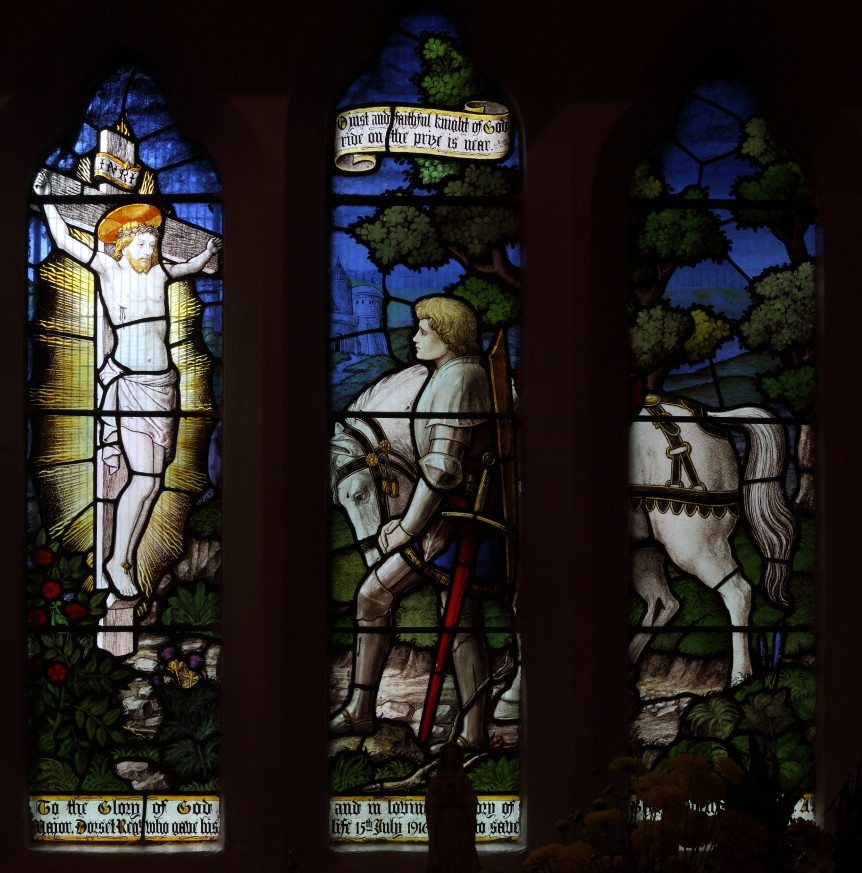In Heroism and Genius, the author, speaking about the spirit of chivalry, wrote:
«Chivalry’s vision of warriorhood penetrated the hearts of many of Europe’s knights. Indeed it even roused some of them to lifelong heroism, whereby they renounced all that men hold dear—marriage, family, independence and fortune—to go and dwell in monastic fortresses, sallying forth to fight, and often die, amid desert sands in the Middle East for the defense of the Holy Land. For these knights, and for many others, a vital element of chivalry’s ability to arouse self-sacrifice lay in its vision of Jesus Christ as the supreme hero and ideal warrior.
«The literary and artistic origins of the chivalric Christ lie in the Dark Ages. As far back as the eighth century men had begun to depict in sermon, poem and painting the image of Jesus Christ-Hero. In the stirring eighth-century Anglo-Saxon poem, The Dream of the Rood [Cross], the author (possibly Cynewulf, a priest of Lindisfarne, the abbey founded by St. Aidan), portrayed Jesus Christ not as a victim who passively suffers but as a warrior on quest to save mankind. He, and not his enemies, chose the site of combat: “The young warrior stripped himself—he, God Almighty—strong and stout-minded; he mounted high gallows, bold before the throng, resolved to loose man’s bonds….”
«This depiction of Christ as warrior became a typical literary figure of chivalric romances during the medieval period. It can be seen in the fourteenth-century poem, The Vision of Piers Plowman, where Christ is portrayed as a famous and redoubtable knight who rides to a tournament in disguise so that his enemies may not recognize him and decline to enter into contest. The Divine Knight, clad in armor, is portrayed with all the chivalric virtues. On the Cross of Calvary he jousts against his mortal enemy, Satan, in a conflict in which the stakes are nothing less than the rescue of humanity from satanic power. Another medieval poem entitled “How God’s Son was armed on the Cross” has the opening line “Hear now, lords, about great chivalry.” One written by the knight Geoffroi de la Tour Landry is full of a soldier’s poignant admiration for Jesus Crucified:
«‘And thus for compassion and nobility the gentle knight fought and suffered five mortal wounds, as the sweet Jesus Christ did, who fought out of pity for us and all mankind. He had great compassion lest they fall into the shadows of Hell. Therefore, in solitude, he suffered and fought the terribly hard and cruel battle on the tree of Holy Cross. His shirt of mail was broken and pierced in five places, namely his five grievous wounds received by his free will in his sweet body, for pity of us and all mankind.’ (Quoted in M. Y. OFFORD, The Book of the Knight of the Tower)
«This was the vision of Jesus Christ that resonated in the imaginations of medieval knights. By observing the God-Man from this angle knights discovered a masculine heroism that made it possible for them to identify with him as warriors. Indeed, in the divine person who “for us men and for our salvation” had stripped himself of the vestures of glory in order to be born in Bethlehem as a man “like them in all things except sin”, they saw the peerless paragon of the hero. Heroism followed heroism in a life of generosity in which the God-Man unleashed his energies during long hours of prayer, endurance of temptations amid the desert, and fatiguing journeys along the roads of Israel. Surrounded by suspicious enemies and misunderstanding disciples he took the road to Jerusalem knowing full well what awaited him. Rejecting all compromise, resolving in the darkness of Gethsemane to drink the bitter cup to the dregs, at the height of his manhood he seized the cross as a knight would seize his sword and poured out his last drop of blood doing battle with the Prince of Darkness on the hill overlooking the world. No deeper suffering! No greater heroism! No more glorious role model!
«Gazing on this image of the courageous Christ men became aware that before riding to the theatre of war manhood demanded self-combat through struggle against sin; that in a fallen universe loyalty to Christ and eternal salvation implied unavoidable spiritual warfare, battling relentlessly and without giving an inch of ground against the triple enemy: the corruption of the world, the Prince of Darkness and the gravitational pull toward egotism within the essentially good but warped human heart. They also came to view the risking of their own bodies in just warfare as their particular way of following Christ. A chronicler wrote of the courageous Louis IX that “as our Lord died for the love he bore His people, even so King Louis put his own body into adventure….for the very same reason.”
«Among the loftiest of chivalrous knights this was the inspiring vision. The official title of the Templars said it all: “Poor Fellow-Soldiers of Christ and of the Temple of Solomon”. It was a spirit they had received from the Church through some of the men whose mission it was to teach, sanctify and lead: the priests. Those priests who embodied the vision in their own lives were the most effective teachers. Among them, the one who brought chivalry to the peaks of idealism was the man who has been called “the conscience of the twelfth century”: Bernard of Clairvaux (1090-1153).» (William J. Slattery, Heroism and Genius: How Catholic Priests Built Western Civilization)

